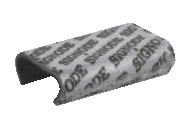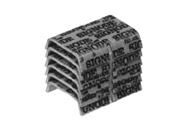Basic seal joint types
Notch joint
One way to lock strap ends is to cut, or “notch” the seal and the strapping it joins to form tabs at the edges. These tabs are bent down (down notch joint) or bent up (reverse notch joint). The strength of the notch joint comes from the mechanical interlock between the seal and strapping. Notch joints are typically used on waxed strapping in packaging and unitizing applications.


Crimp joint
Another way to seal the ends of strapping is to press, or “crimp” undulations into the seal and strapping ends. The strength of the crimp joint comes from the deformed seal creating high frictional forces. Crimp joints produce high static and dynamic joint strengths and are used on applications like rail car loading in which the strapped load is subject to severe impact.

The choice of a specific seal is often most strongly influenced by the type of tool or machine selected to apply it.
Six standard seal types
Snap-on seals
Placed over the overlapping strap ends either during or after tensioning the strapping. Eliminates pre-threading. Speeds the strapping operation.

Thread-on seals
Must be threaded over the overlapping strap ends before the tensioning tool is applied. Generally used on bales, bundles and the larger strap sizes.

Open-flange seals
Heavy-duty version of the snap-on. Requires no pre-threading.

Push-type seals
Used where strap is tensioned by butting the nose of the tensioner against the seal. Overlapping flanges withstand the higher stress.

Nestack seals
Held together by interlocking nibs. This Signode development permits loading partial stacks into magazines of seal feed combination tools and power strapping machines

Microgrip seals
For severe impact applications using waxed strapping. Microgrip seals are coated inside with a high-friction grit which bites through the wax to provide maximum holding power.

Plastic joint types
Normal packaging rates for any application influence both the choice of strap and its joining methods. For low-volume, low-tension strapping of lightweight packages or bundles, Signode Steelock or Dylock buckles are probably the most economical method of joining strap, since they require no special sealing tool.
Seals for hand tool application
All types of 12mm Signode plastic strapping as well as 16mm High-Strength Tenax strapping can be sealed with hand tools using metal seals. Signode manufactures snap-on seals for manual sealers and Nestack seals for use in combination strapping tools with seal magazines.




